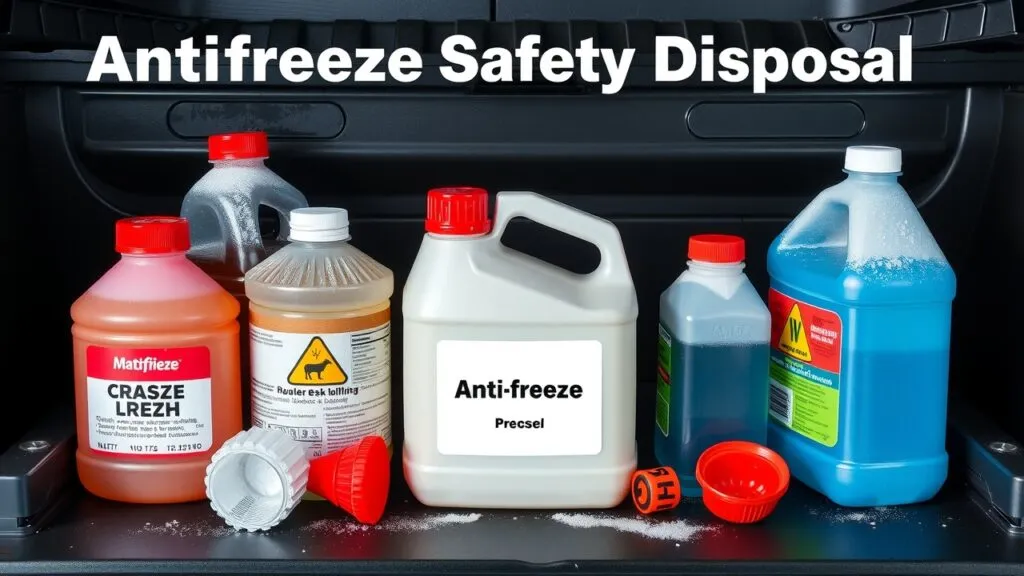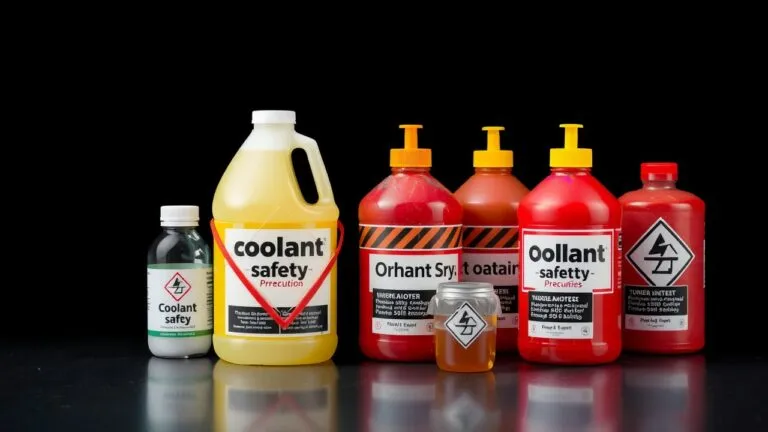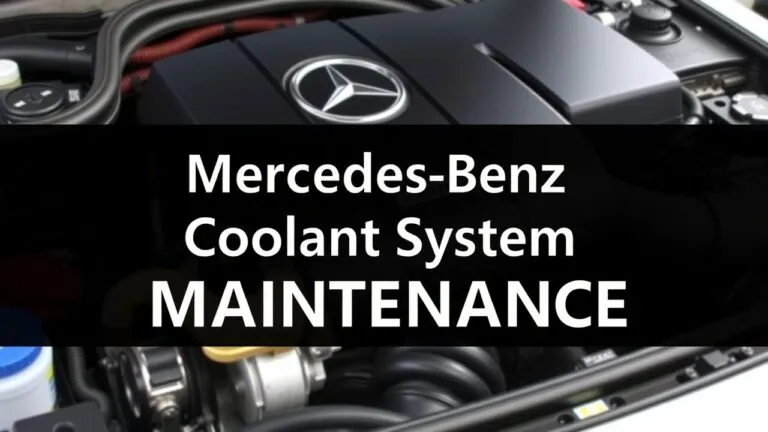Types of antifreeze, like ethylene glycol and propylene glycol, differ in properties and applications. Choosing the right one depends on factors such as engine type, climate, and intended use.
What is antifreeze?

Antifreeze, or engine coolant, is a crucial fluid in your vehicle. It helps control the engine’s temperature. In cold weather, antifreeze stops the water in the cooling system from freezing. When it’s hot, it prevents boiling over. Traditional antifreeze usually contains either ethylene glycol or propylene glycol mixed with water. This mix efficiently transfers heat away from the engine and fights corrosion.
Why is antifreeze important for your vehicle’s engine?
Antifreeze is key to preventing engine damage. It keeps the engine running at a safe temperature. Without antifreeze, an engine can overheat because it can’t transfer heat properly. This could cause major problems and costly repairs. Antifreeze also works as a heat transfer fluid that gets rid of excess heat during combustion. Regularly maintaining coolant levels is important so it can keep doing its job well.
Key differences between antifreeze and coolant
Many people think “antifreeze” and “coolant” mean the same thing, but they don’t. Antifreeze refers to the concentrated liquid you add to the cooling system. Coolant, on the other hand, describes the mixture of antifreeze and water that actually circulates through your car’s system.
| Aspect | Antifreeze | Coolant |
|---|---|---|
| Definition | Concentrated liquid | Mixture of antifreeze and water |
| Purpose | Lowers freezing point | Regulates temperature; prevents overheating |
| Composition | Ethylene glycol or propylene glycol | Typically 50% antifreeze + 50% water |
Knowing these differences helps you make smart choices about your vehicle’s maintenance needs when it comes to automotive fluids.
Main Types of Antifreeze Explained
Ethylene Glycol-Based Antifreeze
Ethylene glycol-based antifreeze is the most common type used in cars. This traditional antifreeze is great at transferring heat, helping keep your engine at the right temperature. It can lower the freezing point and raise the boiling point of the coolant. This means your vehicle can work well in very hot or cold weather.
This antifreeze usually has corrosion inhibitors mixed in. These additives protect your engine parts from rust and wear, which can lead to expensive repairs. Regularly using this kind can help your car last longer and perform better when temperatures drop or soar.
Propylene Glycol-Based Antifreeze
Propylene glycol-based antifreeze offers a safer choice for many drivers. It’s less toxic than ethylene glycol, making it a smart option for places where someone might accidentally drink it. This makes it good for food-grade situations and vehicles carrying food, like RVs or boats. Plus, it’s better for the environment.
Propylene glycol also provides solid freeze protection, similar to ethylene glycol. Many people are choosing it because they want safety without losing performance.
Safety Concerns with Ethylene Glycol vs Propylene Glycol
Safety is key when picking between these two antifreezes. Ethylene glycol has higher toxicity levels than propylene glycol. If ingested, it can be dangerous for both people and pets. So, it’s crucial to handle both types carefully to avoid any health issues if there’s a spill or exposure.
Both types are effective at stopping freezing and overheating, but knowing their differences helps keep everyone safe.
Common Use Cases in Vehicles
Most cars and trucks use ethylene glycol antifreezes because they work well in many climates. However, propylene glycol is becoming popular too, especially in special cases like RVs and boats that might be near wildlife areas.
Recognizing how each type works in cooling systems helps you choose what’s best for your vehicle while considering safety around sensitive spots.
Advanced Coolant Technologies
Organic Acid Technology (OAT) Coolants
Organic Acid Technology (OAT) coolants offer solid protection for your vehicle’s cooling system. They use organic acids instead of traditional silicates or phosphates as corrosion inhibitors. This means they help prevent rust and corrosion in important parts like the radiator and engine block.
One great thing about OAT antifreeze is its long lifespan. Usually, these coolants last up to five years or 150,000 miles before needing a change. That makes them a smart choice for modern cars. They work well in newer models that need specific formulas to keep running smoothly.
When picking an antifreeze type for your car, check if it needs OAT coolant based on what the manufacturer suggests. Using the right type helps your car’s cooling system work better and last longer.
Key Benefits of OAT Coolants:
- Long-lasting protection
- Fewer replacements needed
- Great for newer vehicles
Hybrid Organic Acid Technology (HOAT) Coolants
Hybrid Organic Acid Technology (HOAT) coolants blend both conventional and organic acid tech. They include a mix of organic acids along with some traditional additives like silicates. This combo boosts their ability to protect against corrosion.
So, what’s the main difference between HOAT and OAT coolants? Both offer good protection against rust and scale build-up, but HOAT antifreeze is usually better for older vehicles. It has extra ingredients that help it perform well in different systems.
HOAT is ideal for hybrid systems found in many light trucks and cars today. It’s flexible enough to work effectively across various temperature ranges while still protecting against wear.
HOAT Coolant Highlights:
- Mix of old-school and modern tech
- Works well in many vehicles
- Better for older models
Knowing about these advanced coolant technologies can help you choose the right antifreeze for your vehicle’s needs. This way, you can keep your engine running smoothly for a long time!
Choosing the Right Antifreeze for Your Vehicle
Choosing the right antifreeze is key for keeping your vehicle’s engine in good shape. There are different antifreeze types for cars and trucks, each tailored to meet specific needs. Knowing these differences helps you find the best antifreeze for your vehicle.
Factors to Consider
When picking automotive antifreeze, start with your vehicle type. Cars and trucks have different requirements based on their size and engine specs. Always check your owner’s manual for manufacturer recommendations on coolant types; this makes sure it works well with your engine parts.
The climate where you live also matters when selecting antifreeze. In places with cold weather, using a higher amount of ethylene glycol-based antifreeze gives better freeze protection. On the other hand, if you’re in warmer areas where overheating can happen more often, consider using an organic acid technology (OAT) coolant. This type offers great heat resistance.
Checking and changing engine coolant is an important part of regular vehicle maintenance. Doing this helps stop corrosion in the cooling system while keeping your engine running smoothly during summerizing and winterizing.
Understanding Coolant Color Codes and Their Significance
| Color | Type | Notes |
|---|---|---|
| Green | Conventional | Has silicates; good for older models |
| Red | OAT | Lasts longer; protects against rust |
| Orange | HOAT | Hybrid formula for extended life |
| Yellow | Universal | Works with various systems |
Knowing these colors helps you use compatible products when topping off or changing your car’s coolant.
Risks of Mixing Different Types of Antifreeze
Mixing different antifreeze types can cause several issues in your cooling system. Problems include less effective temperature control and a higher chance of corrosion due to chemical reactions between traditional antifreezes like ethylene glycol and newer formulas like OAT or HOAT.
Always check car coolant compatibility before adding new fluids to avoid damage from mixing incompatible products. Following manufacturer guidelines and regularly checking fluid levels during maintenance checks is a smart idea.
Understanding the types of antifreezes out there—along with considering factors like vehicle type, climate conditions, color codes—and being aware of mixing risks will help you keep your vehicle’s cooling system working well.
Comparison Highlighting Key Differences Between Major Types
Understanding the different types of antifreeze is important for keeping your vehicle’s cooling system in good shape. Each type has unique features that affect performance, safety, and how long it lasts.
Ethylene Glycol
Ethylene glycol is the usual pick for automotive antifreeze. It works well at transferring heat but can be very toxic. You should handle it carefully to keep pets and kids safe. It’s commonly found in silicate and phosphate formulas and usually needs changing every two years.
Propylene Glycol
Propylene glycol is a safer choice than ethylene glycol. Often called food-grade antifreeze, it’s less risky if someone accidentally ingests it. While its heat transfer abilities aren’t as strong as ethylene glycol’s, it also has a two-year lifespan before it should be changed.
OAT (Organic Acid Technology)
OAT antifreezes use organic acids instead of traditional additives like phosphates or silicates. This means they protect against corrosion better and can last up to five years between changes. Their toxicity levels are moderate, making them a decent option for modern vehicles that have aluminum parts.
HOAT (Hybrid Organic Acid Technology)
HOAT coolants mix features from both regular antifreezes and organic acid types. They share many benefits with OATs but also include special additives for better performance in various conditions. Like OATs, they last about five years before needing replacement and have moderate toxicity levels.
Choosing the right type of car antifreeze depends on your vehicle’s needs and your personal preferences regarding safety and environmental impact.
Proper Maintenance Practices for Your Cooling System
Keeping your vehicle’s cooling system in good shape is super important. Regular antifreeze maintenance prevents overheating and protects parts from damage. Knowing about different types of coolant can help you decide when to make a change.
When Should You Flush or Replace Your Coolant?
It’s time to flush or replace your coolant if it’s been too long. Usually, you should change your coolant every 30,000 miles or every two years. But remember, this can change based on how old your car is or how you use it. For newer cars with special coolants, like Organic Acid Technology (OAT), you might only need to do this every five years or 150,000 miles.
General Intervals Based on Vehicle Age/Usage Patterns
- Newer Vehicles: They don’t need changes as often because they use better fluids.
- Older Vehicles: Check more often since older cars are likely to have leaks and other issues.
- Heavy Usage: If you often tow stuff or deal with heavy traffic, consider changing the coolant more frequently.
Signs Indicating a Need for Immediate Replacement
Look out for signs that show it’s time for a coolant change:
- Overheating Engine: If your engine gets too hot, that’s a clear issue.
- Discoloration of Coolant: If the fluid isn’t bright and looks rusty, it needs changing.
- Low Coolant Level: If it drops often, there may be a leak. Regularly check your antifreeze levels.
Tools You’ll Need to Test or Change Coolant at Home
If you want to do a DIY antifreeze change, gather these tools:
- A radiator flush kit
- A funnel
- A container for used coolant
- Safety gloves
- Refractometer: This tool measures specific gravity to check coolant concentration accurately.
- Test strips: Quick but not as precise as refractometers.
Refractometers vs Test Strips Accuracy Overview
When testing coolant concentration:
- Refractometers give precise measurements based on specific gravity and glycol content.
- Test Strips are faster but may not always be reliable.
Safe Handling and Disposal
Always handle antifreeze safely because it’s toxic. Wear gloves when working with automotive fluids. For disposal, take used antifreeze to recycling centers instead of dumping it down the drain or onto the ground.
Following these maintenance tips will help keep your engine running well and prolong its life through smart use of antifreeze options available today.
Antifreeze Safety and Disposal
Antifreeze is important for your car’s engine, but it can be dangerous if not handled properly. Learning about antifreeze toxicity, safe handling, and how to dispose of it safely helps keep you and the environment safe.
Antifreeze Toxicity and Poisoning: Symptoms, Treatment, and Safe Handling
Antifreeze contains either ethylene glycol or propylene glycol. Ethylene glycol is very toxic for people and pets if swallowed. Common symptoms of antifreeze poisoning include:
- Nausea
- Vomiting
- Headaches
- Dizziness
- Seizures
- Coma in serious cases
If you think someone has ingested antifreeze, get medical help right away. Doctors may give activated charcoal to soak up the poison or provide fluids to help the kidneys.
For safe handling of automotive fluids like antifreeze:
- Always wear gloves.
- Keep it away from skin and eyes.
- Store antifreeze in labeled containers out of reach of kids and pets.
Following these safety steps during tasks like changing coolant can lower health risks.
Proper Disposal of Antifreeze: Local Regulations and Recycling Options
Disposing of used antifreeze must be done carefully due to its environmental dangers. Many local laws say you cannot pour it down the drain or throw it in regular trash because it can pollute water sources.
Here’s how to dispose of it properly:
- Check Local Regulations: Contact your waste management facility for rules about hazardous waste disposal.
- Recycling Options: Many auto parts stores have recycling programs where you can drop off used coolant for safe treatment.
- Professional Services: Some mechanics will take care of disposal when they work on your vehicle.
Properly getting rid of old coolant protects the environment and meets legal requirements regarding hazardous materials.
Safe Storage of Antifreeze
Storing automotive chemicals correctly is key for safety at home. Keep antifreezes in a cool place, away from sunlight, to stop them from breaking down over time. Make sure containers are tightly sealed to prevent leaks that could harm children or pets.
Also remember:
- Use anti-cavitation agents if recommended by the manufacturer during storage.
- Check stored products regularly for damage, like rusted cans or cracked bottles, which can cause spills.
These storage tips will help keep your garage safe while managing different car fluids responsibly.
FAQs About Antifreeze Types
What is DEX-COOL antifreeze?
DEX-COOL is a type of coolant designed for GM vehicles. It uses organic acid technology and has a longer lifespan than traditional antifreezes.
What are G11, G12, and G13 coolants?
These are specific coolant types used mainly in European cars. G11 is a conventional coolant, while G12, G12+, and G13 use organic acid technology for better protection.
Can I mix different antifreeze types?
Mixing different antifreeze types can cause issues. It can lead to poor performance or corrosion. Always check compatibility before mixing.
What is the best antifreeze for Asian vehicles?
Asian car antifreeze typically uses different additives. Look for products labeled as suitable for Asian cars to ensure proper performance.
How do I check my antifreeze level?
Check your coolant reservoir while the engine is cool. The reservoir has minimum and maximum lines to guide you on the correct level.
Additional Points About Antifreeze
- Glycol Types: Ethylene glycol and propylene glycol are common. Ethylene glycol has higher toxicity, while propylene glycol is safer.
- Antifreeze Additives: These include corrosion inhibitors that protect engine components from rust and wear.
- Boiling Point: Antifreeze can raise the boiling point of the coolant, allowing engines to operate at higher temperatures without overheating.
- Color Codes: Different colors indicate specific formulations; for example, green often signifies traditional antifreeze with silicates.
- Summerizing Vehicles: Summer coolant may have additives that prevent evaporation during hot months.
- Coolant Flush: This process removes old coolant and contaminants from the system, ensuring optimal performance.
- Checking Coolant Temperature Sensor: Regular checks help ensure accurate temperature readings, preventing overheating issues.
- Low Coolant Level Symptoms: Warning lights or overheating engines signal a need for maintenance.
- Water Pump Role: It circulates coolant throughout the engine, playing a vital role in heat transfer.
- Proper Disposal Methods: Dispose of used antifreeze at local recycling centers to protect the environment.
By understanding these points about antifreeze types and properties, you can make informed decisions about vehicle maintenance.
Related Topics
- Types of coolant
- Types of antifreeze additives
- Types of glycol
- Types of coolant technology (OAT, HOAT, IAT)
- Types of antifreeze toxicity
- Types of coolant disposal methods
- Types of coolant test methods (refractometer, test strips)
- Types of vehicle cooling systems
- Types of antifreeze for different vehicles (Asian, European, GM)



Types of Antifreeze: A Complete Guide